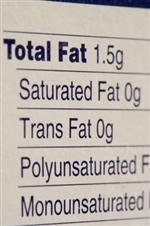If you have an eye for numbers you might wonder why the breakdown of the individual types of fat (mono, poly and sat) listed in my nutrition data usually add up to less than the total fat. For example, one recipe lists the fat content like this: Total Fat 11g (Mono 5g, Poly 2g, Sat 1g). The answer requires a little “Chemistry 101” so bear with me. I’ll make it easy.
All fat molecules are made of three chains, called fatty acids, which are connected to a base. Picture a chain link fence where the poles holding it up are the base and the chain links are the fatty acids. There are different types of fatty acid chains– monounsaturated, polyunsaturated and saturated —which give the fat its defining characteristics.
So here’s where the numbers come in: the total fat is a measure of the entire “fence” (the poles and the chain links) whereas the mono, poly and sat fat only pertain to the chain links. Also, there are trace amounts of naturally occurring trans fat (another kind of link) in many foods that is not reflected in my analysis. Plus, all the numbers are rounded to the nearest tenth, so that affects the total too, however slightly. In all, that’s why the mono, poly and sat fats usually add up to less than the total fat.



